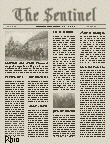LeMars Sentinel, Jan. 3, 1930
HENRY: (Special Correspondence)
Santa Claus visited the school No. 5 last Tuesday afternoon. The school
children gave a program and later in the afternoon they received presents
from each other and from the teacher. They also were given bags of candy and
nuts.
LeMars Sentinel
June 4, 1937
HENRY CENTER: (Special Correspondence)
A picnic was given in the LeMars park by the children of the Henry township No. 5, where Miss Gladys Parry is teaching. About fifty people were present.
Sioux City Journal, September 12, 1954, page 13
Remsen Rural School Pupils Help Writer With Corn Country Book
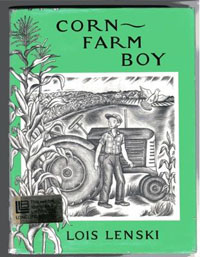
REMSEN, Ia. – Nine grade school farm children near here, know something of what it feels like to write a book. During the winter and spring of 1953, Lois Lenski, authoress of a series of books for children, requested that the pupils of rural school Henry No. 5, 12 miles southeast [northeast] of here, write her detailed information about their everyday activities.
Miss Lenski was preparing another children’s book. This time it was to deal with the Iowa corn country, and she wanted it as factual as possible. So she decided to get her material from those who knew the subject best—the corn-farm children themselves.
It all began when some grade school pupils in Cedar Rapids, Ia., wrote Miss Lenski to express their appreciation for one of her recent books. In their letter they suggested that she write a book about farm life in Iowa.
Somewhat later Mrs. Celeste Frank, teacher in Henry No. 5 at that time, had her class read Prairie School, a Lois Lenski book about South Dakota. Then, as an assignment for her English class, Mrs. Frank asked each of the pupils to write the authoress and tell what they liked about her most recent effort.
The letters were sent to the J.B. Lippincott Co. in Philadelphia, publishers of Lois Lenski’s books. They in turn forwarded them to Tarpon Springs, Fla., where Miss Lenski spends her winters. Mrs. Frank says that her class had written authors before, and experience had taught them not to expect a reply.
Asks Aid of Pupils
But only two weeks later a letter came from writer Lois Lenski. She said the she was then considering the possibility of doing a book about corn farming. She wanted to know if the pupils in Henry No. 5 would help her, sending her detailed facts about their lives on the farm.
Mrs. Frank thought the request a good one, especially since it would help promote the theme state educators were stressing that year—creative English. So Mrs. Frank instructed the class to write Miss Lenski whatever she wanted to know.
This is how a curious exchange of correspondence began between nine grade school children and a noted authoress.
“One night dad went out to feed the pigs,” wrote Carole Ann Baldes, 12, in one of her letters to Miss Lenski, “and I came with him. When he let the oats out of the bin into a basket, four little mice came sliding down the chute, too. We put them out for the cats to eat. That was the easiest supper they ever had. One cat was a little selfish. She got two.”
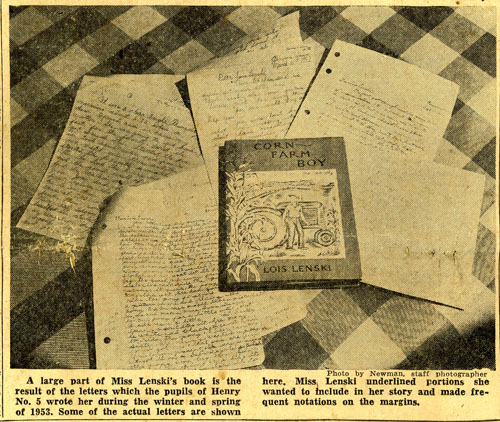
Sought Local Color
This was the type of folksy, homespun information that Miss Lenski wanted. It was the sort of local color that she knows makes for good books in her series.
“We have new baby calves again,” wrote 12-year-old Martha Mae Guttner. “These are the first brown and white calves we have had. We are going to name them Spot, Blacky and Sue. We thought that those are good names for them.”
Miss Lenski never answered the letters individually, but rather wrote the whole class jointly. Often, though, she commented upon what one or the other had written and always asked many questions. As the children learned to know the authoress better, they wrote ever more freely. “And their style of letter writing improved as well,” recalls Mrs. Frank, happily.
From their mutual correspondence, the children learned that Lois Lenski was born in Springfield, O., and that she graduated from Ohio State university in 1915. Later she had studied at the Art Students’ league in New York city, then abroad at the Westminister School of Art in London. It was on her return to America, the children learned, that Miss Lenski wrote her first book, Skipping Village, in 1927. Since that time, she told them she has written and illustrated many books.
Send Drawing Also
Not only did the children write Miss Lenski letters about their everyday activities, but, at her suggestion, they sent her drawings as well. They made pictures of their homes and farm buildings, drew members of their families and outlined maps depicting the area of each of their farms.
Whenever a new letter came from Lois Lenski, Mrs. Frank would make a list on the blackboard of the things she asked about. The children wrote her on these subjects during English class or in their spare time. On her desk Mrs. Frank kept a large envelope into which the letters and sketches were placed when finished.
In the summer of 1953, Lois Lenski flew to Remsen from her summer home in Connecticut to be the house guest of Mrs. Frank. Miss Lenski hoped to avoid all publicity and tried to keep the purpose of visit as casual as possible. To this end she used her married name, Mrs. Arthur Covey, since Lois Lenski, her maiden name and pen name, might be more easily recognized.
Visits Nearby Farms
The first thing that Miss Lenski did was to meet the nine pupils of Henry No. 5 with whom she had been corresponding. During her two and a half weeks in this vicinity, Miss Lenski made daily visits to surrounding farms, especially those of the children who had been helping her with the book.
At each place she stayed for a meal. As she sat at the table, Miss Lenski kept a notebook and pencil inconspicuously on her lap. Often she took down the informal conversations she heard verbatim. At other times, she used her notebook as a sketch pad, drawing homey scenes of rural Iowa. Later these sketches would be used to illustrate her book.
Among other farms near Remsen, she visited those of Mr. and Mrs. Henry Baldes, Mr. and Mrs. Ray Leinen, Mr. and Mrs. Elmer Guttner, Mr. and Mrs. John Lapora and Mr. and Mrs. Ralph Meister. Each of these families had children in Henry No. 5. While she was at the farm homes, it was these same children in the particular family involved that acquainted Miss Lenski with such things as farm machinery, the various animals and the types and purposes of farm buildings.
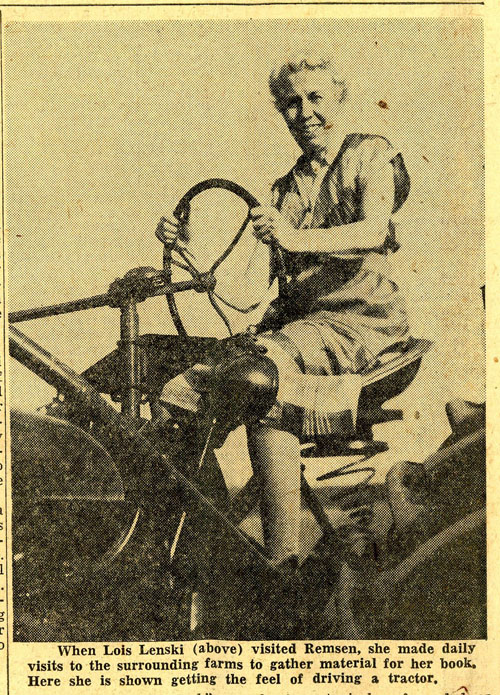
“It was the most exciting summer the children ever had,” says Mrs. Frank. “After all, it’s not everyone who has a chance to help a noted author write a book.”
Presently Miss Lenski began putting together her story. The main character was to be a 12-year-old corn-farm boy. Her inspiration came from three actual rural school pupils—Noel Leinen, 13, and brothers Ken and Jerry Meister, 11 and 15, respectively. Miss Lenski admits that the Dick Hoffman of her book, about whom the story evolves, is a composite of these three boys. She thinks that this should make him just about typical a farm lad as could be found.
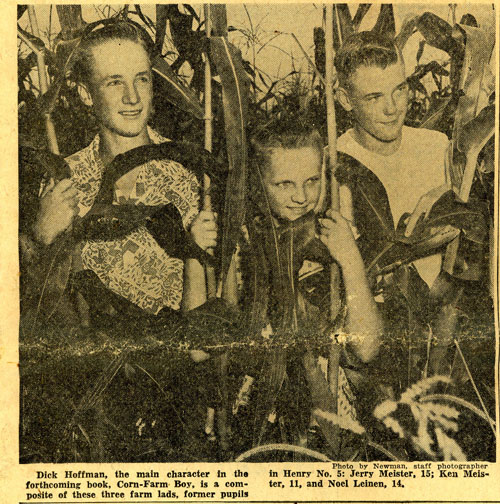
School Does Not Reopen
Today the children do not attend Henry No. 5. In fact, the school did not even open this year. Consolidated schools are replacing the one-room variety in which most rural adults in the vicinity were educated. The nine children themselves, at ages where one year can make a big difference, no longer look the same as when Miss Lenski saw them last. Only their lives have been changed. And it is this, their lives, that Miss Lenski will publicize in her latest book.
On September 22, the book entitled Corn-Farm Boy, will be published by Lippincott. It is the date that the former pupils of Henry No. 5 have been awaiting for almost two years. They consider the volume “their book.” And it is.
Chapter on Marketing
The chapter called Market Day may be especially interesting to Sioux Cityans. When Miss Lenski was here, she neglected to come to the Sioux City stockyards, overlooking at the time that selling cattle is a high point in an Iowa farmer’s life. At the request of Miss Lenski, Mrs. Frank later visited the stockyards here for her in December of 1953. She made detailed notes and sketches of the activities she saw and spoke with a number of officials. This information she then sent to Miss Lenski, who later developed it into the chapter, Market Day.
Today Carole Ann Baldes, Norma and Noel Leinen, Aliene and Miriyam Lapora, Ken and Jerry Meister and Martha Mae and Mary Ellen Guttner—all former pupils of rural school Henry No. 5—know something of what it means to write a book. The actual stringing together of the words was done by Miss Lenski, of course, but the children supplied the subject matter. And who would argue that one is more important than the other?
Le Mars Globe Post, September 16, 1954 – Henry Township No. 5
Remsen Prepares for a Big Party
For Writer Who Wrote Book
On Henry Township Experiences
It All Started With Fan
Letters From Rural
School Pupils
BY CELESTE FRANK
[Teacher of Henry No. 5]
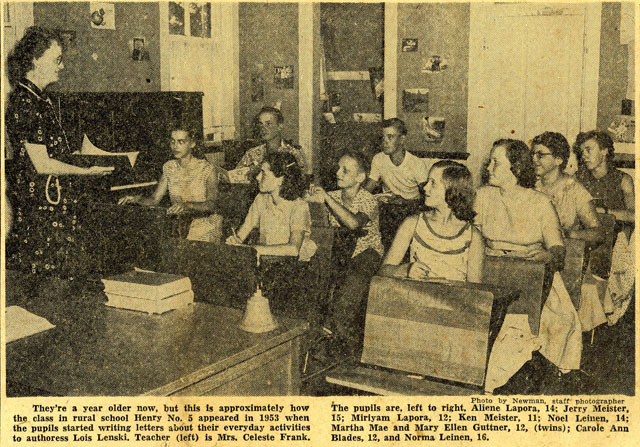
On March 3, 1952, my pupils in Henry township No. 5, a one-room school in Plymouth county, wrote letters to Lois Lenski, to tell her how much we enjoyed reading her regional South Dakota book, Prairie School. My third grader, Kenny Measter [Meister], who loves to draw, cut out a paper heart, and on it sketched the school and grain elevator scene from the book. Each pupil wrote a letter telling why they liked the book. They all thought it was fun to write to “a real live author,” and they wondered if they would get a reply.
Our letters were sent ot he Lippincott Publishing Co., in Philadelphia, and were forwarded to Lois Lenske’s winter home in Florida. Not more than two weeks later, we received answer. How excited the children were when it came!
Mis Lenski said that Cedar Rapids children had suggested that she write an Iowa corn story, but that since they live in a city, they could not help her much. She asked if we loved our corn farms, and if we “knew all about corn farming.” She suggested that we write her about our every-day lives.
Needless to say, we were thrilled at the prospect of helping an author write a book, and flattered, too, to think our lives on the farm were so important.
As their teacher, I thought the suggestion a good one. Creative English was being stressed by Iowa educators for the school. What better way to practice creative writing than under the expert tutelage of a noted author who asks for our help and promises to make it “easy for us?”
First we were anxious to learn more about Lois Lenski herself. From information sent by her publishers, and what she told us herself, we learned that she uses her maiden name as her pen name. In private life she is married Arthur Covey, a noted mural painter. They have a grown son, also an artist, now in the army.
They live in Connecticut in the summer, and spend their winters in Florida.
Lois Lenski is a middle westerner, as she was born in Springfield, Ohio. Her first book was published in 1927. She has written books for all ages from pre-school to junior high.
As she is also an artist, she illustrates them herself. We have enjoyed reading many of them.
We hardly knew where to begin, but she told us not to worry—that she would ask questions and we could answer them. She gave us many ideas as we went along. She suggested that we talk over our experiences first, before trying to write about them, and that the younger children, who find writing difficult, tell or dictate their experiences for the teacher to take down.
We wrote her individual letters, but her replies were always joint letters to all, in which she mentioned the pupils by name. So we shared her letters, reading them aloud. Each letter we received from her was a great stimulus to further writing. Each contained more questions for us to answer.
She helped the children to avoid generalizations and to write in concrete detail of their experiences. The children soon learned than an author is very curious, and wants to know many (to them) unimportant details. As the children learned to know the author better, they wrote more freely and naturally, and their letters improved as well.
When Miss Lenski wrote that her publishers were enthusiastic over the idea of an Iowa story, it made us all very happy. We were glad to know that the proposed book was not just a dream, but would, in two years time, become a reality.
We not only wrote her letters, but drew pictures for her—at her suggestion. We drew our farm homes and buildings, maps of each farm, and members of our families. Because the children had little previous experience, Miss Lenski was amazed at how good their drawings were. She wrote:
“They give me a very good idea of what Iowa farm life is like.”
After receiving a letter from Miss Lenski, we made a list of the information she wanted on the blackboard. The children wrote to her on these subjects in language work and in their spare time. I kept a large envelope on my desk, into which letters and sketches were placed.
During the summer of 1952 the children were asked to write down what they did on a typical day, from the time they got up in the morning until they went to bed at night. They were able to write, also, of special experiences such as oats harvest, feeding and care of hogs, pulling cockleburs, corn picking, etc.
In August, 1952, I visited each farm home, asking the children about their experiences and taking them down in a notebook which I later mailed to Miss Lenski. During the corn picking season we told of helping harvest the corn.
We drew pictures of snow fence cribs and corn pickers. Iowa had her largest corn crop in 1952, so we were able to write of a bountiful crop. We made cornhusk dolls and sent them. For Christmas we sent her a prize ear of corn, which she placed on her piano for all to see.
During the winter of 1952-53 the Kitchen Klatter women’s radio program gave publicity to the fact that Lois Lenski was writing an Iowa corn story. By this means the author was put in correspondence with a number of Iowa housewives on farms in other parts of the state, who also contributed from their fund of experiences.
When our school group heard over the radio that Lois Lenski was coming to Iowa in the summer of 1953, the children were very excited and could hardly wait. We began to plan all the things we would do for her when she came.
School closed and we waited until July 11, when she arrived by plane from Connecticut. She requested no publicity be given her visit, especially no mention of it in the newspapers.
Miss Lenski preferred to work quietly, under her married name, Mrs. Arthur Covey, without letting the public know her purpose. She became a guest in my home.
While in Remsen, Miss Lenski made daily visits to the farm homes of the pupils of Henry No. 5 school.
She enjoyed the meals with the families; she interviewed children and parents asking many questions.
Among the farm homes she visited were the following:
Mr. and Mrs. Glen Robinson, Mr. and Mrs. Henry Baldes and daughter Carol Anne. Mr. Baldes is vice chairman of the P.M.A. at Le Mars.
Other farm homes visited were those of Mr. and Mrs. Ray Leinen, parents of Noel and Norma, Mr. and Mrs. Elmer Guttner, parents of the twins, Martha Mae and Mary Ellen, Mr. and Mrs. John Lapora, parents of Ellen and Miriyan, and Mr. and Mrs. Ralph Meister, parents of Jerry and Kenny. She spent nearly a month in the community.
The Corn Farm Boy is the book which came out of the visit.
Miss Lenski enjoyed her visit in our community, and felt very much at home with us. My pupils and I are happy to call her not only our favorite author, but also a real friend. And we are proud of the book, as if we had written it ourselves.
Editor’s note: The above interesting account of the making of a book by Mrs. Frank indicates that she is pretty good at writing herself. Remsen is planning a Publication party on September 25, at the Remsen auditorium, and The Globe-Post hopes to get more detail on this for publication in a later edition. Although names and incidents have been changed in the book, people in Henry township will be able to recognize themselves and friends in many of the characters of the book.
